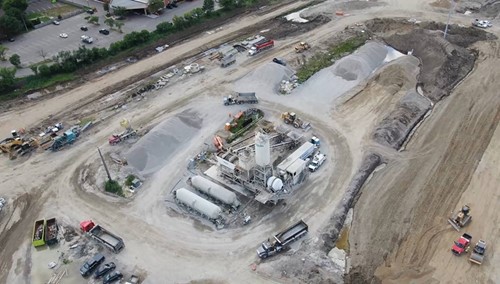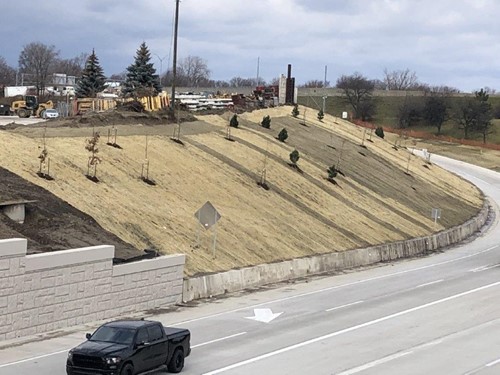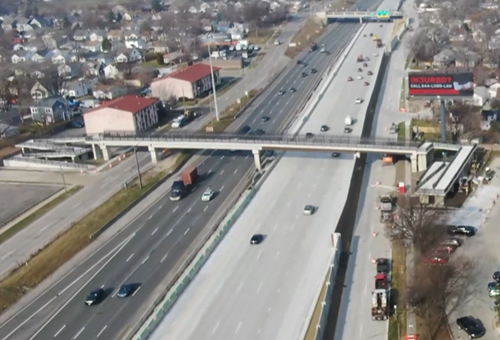Travel I-75
Project Highlights - Environmental Innovations
In the past, the construction industry had contributed to a large part of landfill waste, but the I-75 Modernization Project took steps to reduce that waste and other environmental impacts. By rebuilding pavement and bridges in the same location as the original highway, and providing additional safety, geometric, and mobility enhancements, the I-75 Modernization project recycled and reused the original material.
What were some ways the project is focusing to reduce landfill waste?
Key areas to reduce landfill waste were to recycle concrete, steel, sub-base, and asphalt. The four recycling efforts included the contractors recycling 70- to 100-percent of:
- Previous Portland Cement Concrete pavement used as a road base for new road construction.
- Previous hot mix asphalt was used to construct the tunnel site or other work areas.
- Previous base and sub-base road material was used as backfill material for drainage structures and embankments.
- Steel obtained from demolition operation used on the project or for other steel products in southeast Michigan.
Recycled Pavement and Aggregates
When the pavement was removed, broken up, and stored on the project, the material was recycled and was used as backfill. Concrete is made from aggregates (stones), cement, and water. Mixed and allowed to harden, typical concrete roads and bridges last for up to 50 years before time and pressure break the cement away from the aggregates, and the roads start to crumble. Water does not stay in the concrete forever and the chemical reaction with cement stops. Cement cannot typically be recycled once the chemical reaction ends, but the aggregates are still useable! Engineers and contractors found a way to remove all the aggregates from old concrete through the use of big machines that crushed up the concrete and removed the old aggregates. They can then be used to help reconstruct the roadway base or be used in new concrete mix for the roadway surface. Doing this means that aggregates did not have to be mined, transported on ships or barges, trucked to the project, and moved to where it was needed. Imagine all the gasoline and diesel fuel that was not burned and the emissions that are not created because all those steps could be skipped! The process of reusing the aggregates from the old roadway reduced these environmental impacts as well as reduced scarring of the earth by the mining process. The I-75 Modernization project used recycled aggregates in the layer directly under the concrete, and in the concrete itself, maximizing the use of readily available materials, and limiting environmental impacts.
On-site portable concrete plants
Typically, concrete plants are near rock quarries (mines) or areas where there is a lot of construction. On this project, the contractor used portable concrete plants. As part of the pavement recycling process, once the recycled aggregates came from the crushers, some were diverted to concrete mixing facilities (plants) that mixed aggregates, water, and new cement into concrete to be used for the roadways and bridges. Using portable concrete plants reduced the fuel consumption of concrete trucks and saved the contractor time. The longer a concrete truck trip was, the more fuel was used, so on this project, portable concrete plants reduced fuel usage and emissions that could be harmful to the environment.
 |
| Figure 1: Portable Concrete Plant located at Rochester Road (2020) |
Recycling of reinforcement steel
The original roadway and bridges were concrete construction, with steel added to reinforce it providing additional strength and durability. Today, new steel is very costly to manufacture and creates many environmental impacts ranging from mining iron ore, deliveries to ports, shipping and transporting to steel mills, burning fossil fuels such as coal to heat and create steel. During the crushing process of recycling the old concrete, the steel was sorted out of the crushed material and recycled. The environmental impacts of creating new steel for the project were drastically reduced by recycling millions of tons of steel from the old roads, barrier walls, guardrail, and bridges on this project. All the recycled steel was transported to steel mills in southeast Michigan that melted it down to create a variety of new steel products, from car parts to steel beams.
What are some ways the project reduced environmental impacts?
There were several environmental measures to protect and enhance the natural environment, including:
- Detention Ponds:
- Drainage design introduced controls and countermeasure plans to prevent pollutants from the project from entering water bodies.
- Remediation of contaminated areas within the project’s right-of-way and to prevent future contamination.
- Trees, Landscaping, and Habitat Protection:
- Trees were planted. Landscaping was improved along the corridor providing, habitat and support birds and other wildlife.
- Fencing was installed to minimize vehicle-wildlife interaction.
- Habitat loss was minimized by controlling the project footprint and planting vegetation along roadsides.
- Vegetation clearing was timed to avoid the breeding season for migratory and non-migratory birds.
- A bird sweep was conducted by a qualified biologist to identify wildlife and habitat prior to grass mowing / vegetation clearing and bridge demolition operations.
- Invasive species control was done by removing existing invasive species along the project’s right-of-way and selecting locally appropriate, non-invasive plants for landscaping along the project corridor.
- Carpool lots: Facilitated carpooling and fewer cars on the road, which results in reduced greenhouse gas emissions and improved air quality.
- To the extent possible, excavated earth from the project was used in other locations within the project limits. This was not only a cost savings but was also an environmentally friendly approach that reduced the amount of fuel used to truck soil off the project and reduced the amount of truck traffic on the roadway.
- Storage and Drainage Tunnel: The tunnel captures stormwater from the I-75 freeway, separating the water from the local Oakland County collection system, therefore, reducing the number of combined sewer overflows into the Red Run Drain, Clinton River and ultimately Lake St. Clair.
Detention Ponds
This project constructed several new detention ponds to slow down stormwater runoff. These were being constructed to collect storm water and melted snow runoff from the roadways and bridges. The intent of these ponds was to collect storm water and hold it in place long enough to allow pollutants to settle out of the water and collect at the bottom of the ponds. Doing so kept pollutants from entering larger streams, creeks, rivers, and lakes where it could cause long term damage to these types of ecosystems. The I-75 project had several of these that were constructed. These were not included in the original construction of the roadway, so adding these was a significant improvement to cleaning runoff and improving the water quality of storm water runoff.
Trees and Landscaping
Another environmental benefit was the planting of trees native to Michigan. Every section of roadway that had removal prior to construction, was evaluated for replanting, with some areas receiving more than what was removed. Trees reduce carbon dioxide which can be produced by vehicles using the nearby I-75 roadway. Having more trees will mean additional levels of carbon dioxide will be processed out of the air. The trees and landscaping provide habitat and support birds and other wildlife.
Controlling invasive species along the project’s right-of-way and selecting locally appropriate, non-invasive plants for landscaping along the project corridor.
 |
 |
| Tree Plantings along I-75 at Adams Road (2019) | Tree Plantings along I-75 north of Shevlin Avenue (2021) |
What are additional sustainable objectives that the project is providing?
The project enhanced safety, mobility, economies, and livability throughout the region. It was planned and designed with specific sustainability objectives in mind:
- High-Occupancy Vehicle (HOV) lanes (north of 12 Mile Road to north of Square Lake Road interchanges) and an additional general-purpose lane (M-102 to 12 Mile Road) to reduce congestion and travel time. Visit our HOV Highlight page for more information.
- Flooding risk was mitigated through construction of an underground drainage tunnel. View our Tunnel Highlight page for more information.
- Noise walls were built to help reduce noise pollution.
- Diverging Diamond Interchanges (DDIs) enhanced safety and reduced delays. View our DDI Highlight page for more information.
- Connectivity for the community improved pedestrian crossing structures located over and on each side of the freeway.
 |
| Reconstructed Orchard Avenue Pedestrian Bridge (2020) |

